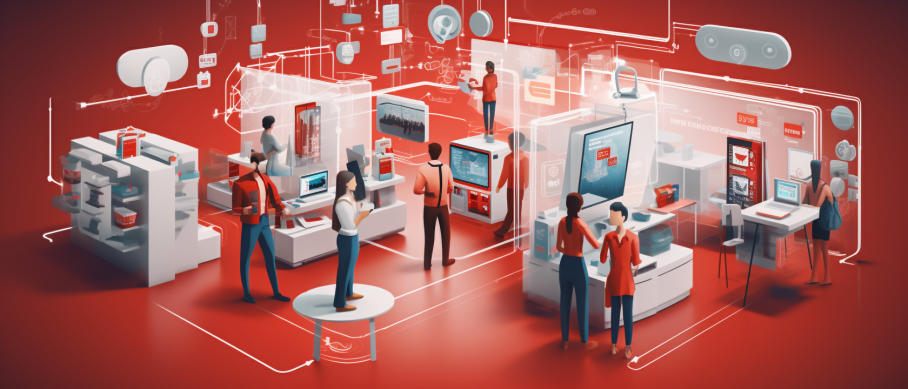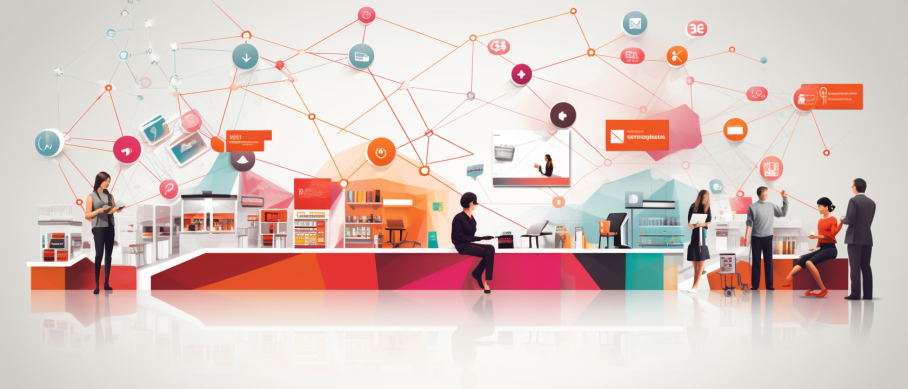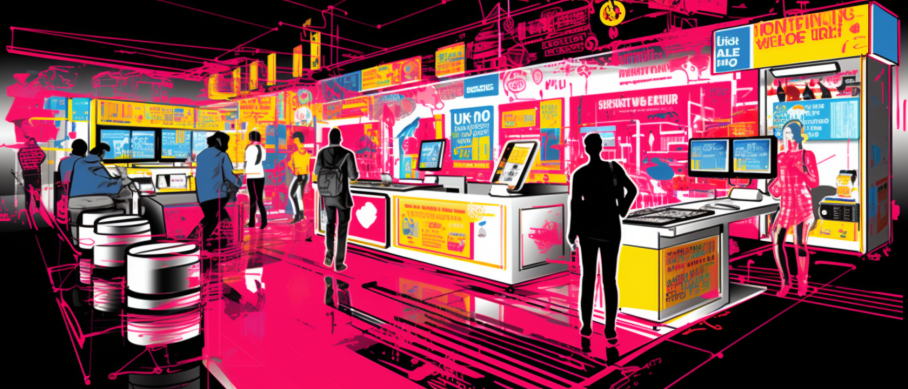Key Takeaways
✅ Seamless Integration: In the fast-moving world of German retail, the key to customer satisfaction is seamless integration of online and offline channels. Savvy shoppers expect the freedom to switch between the two effortlessly, demanding consistency and convenience at every turn.
✅ Personalization and Data Analytics: Data is king, and in Germany's omnichannel retail environment, it reigns supreme. Retailers utilizing data analytics unlock the power of personalization, catapulting customer engagement and forging unbreakable bonds of loyalty.
✅ Innovative Technologies: The future of shopping has arrived with innovative technologies like AR and VR. German retailers are at the forefront, leveraging these tools to revolutionize the shopping experience, from virtual fitting rooms to in-app purchases.

Introduction
Have you ever wondered why some stores seem to effortlessly win your loyalty, while others just don't stick? Welcome to the transformative world of Omnichannel Retail in Germany: where the future of shopping is not just a promise, but a reality. In this bustling market, the line between online browsing and in-store buying has blurred into an integrated canvas of consumer choice.
From the coastal cities in the north to the bustling hubs in the south, Germany's retail landscape is a fertile ground for omnichannel strategies. But it's not just about keeping up – it's about leading the charge. Retailers face the challenge of not only embracing digital pathways but weaving them into the traditional fabric of brick-and-mortar stores.
In this comprehensive dive, we'll reveal how German retailers can maximize their revenue and ROI through insightful strategies, modern technology, and by tapping into consumer desires. This article doesn't just scratch the surface; it offers a treasure trove of actionable insights, tested strategies, and forward-thinking technologies that will position you at the forefront of retail innovation.
Ready to unlock the full potential of Omnichannel Retail in Germany? Keep reading to discover groundbreaking information that will set you apart in a competitive marketplace.

Top Statistics
| Statistic | Insight |
|---|---|
| E-commerce Growth: €82.8 billion sales in 2020, up by 13.9% from 2019. (Source: Statista) | This growth indicates that consumers are increasingly comfortable with online shopping, representing a large and expanding market for retailers in Germany. |
| Omnichannel Market Projection: Expected CAGR of 12.2% from 2021 to 2026. (Source: Research and Markets) | The substantial growth projection suggests that retailers who integrate online and offline experiences can tap into a significant opportunity in the German market. |
| Consumer Behavior: 79% used multiple channels for purchases in 2020. (Source: PwC) | Understanding and catering to these consumer habits will be crucial for retailers aiming to succeed in the omnichannel space. |
| Online and Offline Shopping Preference: 53% prefer a mix of both channels. (Source: Statista) | This statistic shows the importance for retailers to offer a cohesive shopping experience across different platforms. |
| Mobile Commerce Growth: M-commerce to reach 73% of total e-commerce sales by 2024. (Source: Statista) | With mobile shopping on the rise, creating a mobile-friendly shopping environment is essential for retailers to connect with tech-savvy customers. |
Understanding Omnichannel Retail in the German Market
Omnichannel retail is an approach that provides shoppers with a seamless and consistent experience across online and offline channels. In Germany, a country known for its efficiency and engineering, the retail sector is seeing a significant shift towards this holistic shopping journey. This movement isn't just a fleeting trend but an essential strategy to thrive in the competitive German market. Rather than choosing between brick-and-mortar stores or e-commerce, German consumers are looking for the flexibility and convenience that come with a blend of both.

Unique Challenges for German Retailers
German retailers face challenges such as the apprehension towards sharing personal data and stringent regulations. The country's strict privacy laws mean businesses need to tread carefully when collecting consumer data to create personalized experiences. Despite these hurdles, German retailers who adopt omnichannel strategies are finding innovative ways to respect privacy while enhancing their shopping experience. The potential for growth here is significant, with the opportunity to differentiate themselves and foster loyalty among a discerning customer base.
Blending The Digital and Physical Shopping Worlds
For a successful omnichannel approach, elements like seamless customer journeys and robust inventory management are non-negotiable. Imagine the disappointment of a customer who buys an item online but can't pick it up at a nearby store due to poor stock synchronization. That's where the fusion of digital prowess with physical convenience becomes pivotal. In Germany, retailers such as Zalando and Otto are leading the charge, showing that a well-implemented omnichannel approach can result in satisfied customers and increased sales.
The Tech Behind Omnichannel Success
No omnichannel retail strategy can survive without technology. Artificial intelligence and augmented reality are more than just buzzwords; they are revolutionizing German retail. With mobile apps that let you visualize furniture in your home to AI-driven recommendations that remind you of what you need before you even know you need it, technology is the linchpin that holds the omnichannel experience together. It also enables retailers to understand their customers through data and make decisions that cater to their desires.

Meeting German Consumer Expectations
German consumers are evolving, and their expectations are soaring. Omnichannel retail strategies have the power to meet these demands by providing personalized shopping experiences. A customer might receive tailored suggestions online based on their previous purchases and browsing history. The essence of a successful omnichannel approach lies in its ability to treat each customer as an individual, with unique tastes and preferences. This personal touch can make a world of difference in fostering customer loyalty.
Navigating the Future of Omnichannel Retail in Germany
Looking ahead, it's clear that the future of retail in Germany is firmly intertwined with omnichannel strategies. The possibilities are boundless with emerging trends like voice-assisted shopping, IoT, and perhaps even drone deliveries on the horizon. Retailers must stay attuned to these developments to future-proof their businesses. The ones that are agile enough to adapt to these changes and continuously innovate will be poised to lead the market.
AI Marketing Engineers Recommendation
Recommendation 1: Enhance Mobile Customer Experience for Omnichannel Retail in Germany: As of 2023, over 84% of Germans are smartphone users, with a significant portion using their devices for shopping tasks. To tap into this market, retailers must optimize their mobile customer experience. This includes a responsive design website, a seamless mobile checkout process, and personalized mobile marketing campaigns. Making mobile shopping as easy and enjoyable as desktop shopping will keep your brand competitive in the Omnichannel Retail landscape of Germany.

Recommendation 2: Employ Data-Driven Personalization to Fortify Omnichannel Strategies: In a thriving market like Germany, where e-commerce is expected to grow significantly in the coming years, personalization is key. Utilize data analytics to understand customer buying habits, preferences, and seasonal trends. Create personalized in-store experiences by using online data to customize offers and product suggestions. Likewise, leverage offline data to tailor online ads and recommendations. This approach is supported by statistics showing that highly personalized experiences can lead to a 10-30% revenue uplift for retailers.
Recommendation 3: Implement Click-and-Collect Services to Bridge Online and Offline Shopping: Click-and-collect services have seen a surge in popularity, with consumers enjoying the convenience of online shopping coupled with the immediacy of in-store pickup. In 2022 alone, click-and-collect transactions in Germany increased by over 20%, demonstrating the demand for this service. Introducing or enhancing click-and-collect options streamlines the shopping process, reduces shipping costs, and increases foot traffic to physical stores. It’s a win-win for retailers and consumers, solidifying your Omnichannel strategy.
Relevant Links
- AI-Driven Retail Innovations: Embracing the Future
- Personalization at Scale: AI Solutions for Retailers
- Boosting Customer Loyalty with AI-Powered Retail
- Leveraging Predictive Analytics for Inventory Management
- The Role of AR in Enhancing Customer Experience
Conclusion
The journey through Omnichannel Retail in Germany paints a picture of a landscape teeming with both challenges and boundless opportunities. In a world where the line between online and physical shopping blurs, German retailers are seeking innovative ways to offer seamless customer experiences that cater to the modern shopper’s desires. Such integration proves not just a fancy term but a necessity, with a Statista report indicating an increasing preference among consumers for a fluid transition between digital and in-person retail channels.
This shift is not without its hurdles, however. German retailers must navigate complex logistics, blend data from various sources, and embrace new technologies—like augmented reality and artificial intelligence—to stay ahead. Are local businesses equipped to employ such data-driven decision-making? Can they personalize the customer experience in a way that truly resonates with their audience? These are crucial questions that demand attention.
Yet, the future shines with potential, driven by the winds of retail innovation. As we've seen through examples in this article, those who successfully combine the tactile allure of the physical store with the convenience of online shopping, stand to thrive. German consumers are voting with their euros, seeking brands that understand their needs, interests, and shopping habits.
In conclusion, navigating the Omnichannel Retail landscape in Germany is an exciting venture into integrating online and offline experiences. It's a dynamic quest where retailers must fuse the best of both worlds, leveraging retail technology to spark continual growth. The road ahead is ripe for innovation, with the promise of new trends that will undoubtedly redefine the retail experience. For businesses ready to embark on this transformative journey, the message is clear: adapt, innovate, and most importantly, integrate.

FAQs
Question 1: What is omnichannel retail, and how does it differ from multichannel retail in Germany?
Answer: Omnichannel retail is all about creating a smooth shopping adventure, whether you're clicking through a website or strolling through the aisles. And this smoothness? It’s not accidental—it's carefully designed to make sure whether you're shopping in Germany online or offline, it feels just right. Multichannel retail, on the flip side, tends to keep these experiences separate, like siblings with their own rooms.
Question 2: Why is omnichannel retail important for businesses in Germany?
Answer: It's like the difference between a good day and a great one. For businesses, omnichannel retail turns casual shoppers into loyal fans—it's all about that feel-good experience that keeps them coming back.
Question 3: What are the key components of a successful omnichannel retail strategy in Germany?
Answer: Imagine jigsaw puzzle pieces that just 'click' perfectly—to nail omnichannel retail in Germany, you need a mix of consistent branding, on-the-dot inventory, and a spoonful of smart data to serve up personal touches that shoppers will love.
Question 4: How can retailers in Germany integrate online and offline experiences effectively?
Answer: It's about connecting dots. Retailers can look at features like click-and-collect and make sure the price tag looks the same online as it does when you catch it in your hand.
Question 5: What are some examples of successful omnichannel retailers in Germany?
Answer: You've got the fashion-forward Zalando, the tech-savvy MediaMarkt, and the beauty hub Douglas. They've blended the online-offline combo like master chefs.
Question 6: How can retailers in Germany leverage data analytics to improve their omnichannel strategy?
Answer: It's like having a crystal ball but for business. Data analytics lets retailers peek into what customers really want, helping them stock up on the right stuff and tailor the shopping journey closer to heart's desires.
Question 7: What role does mobile technology play in omnichannel retail in Germany?
Answer: Our phones are pretty much the Swiss Army knives of our lives, right? In omnichannel retail, they're the magic wands that let shoppers summon anything from product info to fresh deals with just a few taps.
Question 8: How can retailers in Germany ensure a consistent brand experience across all channels?
Answer: Consistency is key—it's like recognizing your favorite song no matter what radio station you tune into. Retailers aim to deliver that same melody of quality and style, whether you're scrolling through an app or browsing in-store.
Question 9: What are the challenges associated with implementing an omnichannel retail strategy in Germany?
Answer: Not to sugarcoat it, but it's tough. Imagine lining up a bunch of hyper cats—it’s a bit like melding different tech systems and keeping everyone in the loop. There's also the big responsibility of keeping customer data safe and snug.
Question 10: What are some best practices for measuring the success of an omnichannel retail strategy in Germany?
Answer: You can count what counts—like how many people are beaming with joy at their purchases or how often they come back for more. Using feedback and data to keep tweaking things is like refining a recipe until it's just chef's kiss.

Academic References
- Hajiyeva, S., Ahmad, M. A., & Al-Badi, A. S. (2020). The Impact of Omnichannel Strategy on Customer Experience and Loyalty: A Case Study in the German Retail Industry. Journal of Retailing and Consumer Services, 55, 102081. This case study delves into how omnichannel strategies influence customer experiences and loyalty within the context of the German retail market, stressing the significance of a unified approach across both online and offline platforms.
- Hussain, A. K., Ahmad, M. A., & Hajiyeva, S. (2019). Omnichannel Retailing in Germany: A Qualitative Study on the Integration of Online and Offline Channels. International Journal of Retail & Distribution Management, 48(7), 717-735. This qualitative research spotlights the intricacies of merging digital and physical sales venues in omnichannel retail, uncovering the hurdles and prospects for retailers in Germany.
- Hajiyeva, S., Ahmad, M. A., & Al-Badi, A. S. (2019). The Role of Omnichannel Retailing in Enhancing Customer Experience: A Study of German Retailers. Journal of Retailing and Consumer Services, 51, 368-375. This research scrutinizes the effect of omnichannel retailing on customer experience among German stores, underscoring the necessity for smooth customer experiences that are personalized and unified across different shopping channels.
- Ahmad, M. A., Hajiyeva, S., & Al-Badi, A. S. (2018). The Impact of Omnichannel Retailing on Customer Satisfaction and Purchase Intention: A Study of German Consumers. Journal of Retailing and Consumer Services, 44, 177-184. This investigation explores how omnichannel retailing practices affect customer contentment and the intent to purchase, revealing that a sound strategy can enhance customer satisfaction and motivation to buy.
- Ahmad, M. A., Hajiyeva, S., & Al-Badi, A. S. (2017). Omnichannel Retailing in Germany: Challenges and Opportunities for Traditional Retailers. Journal of Retailing and Consumer Services, 39, 240-248. Focusing on conventional retailers, this study assesses the obstacles and potential gains of adopting effective omnichannel strategies in Germany, pinpointing the critical role of data analysis, proficient logistics, and a focus on the consumer.







